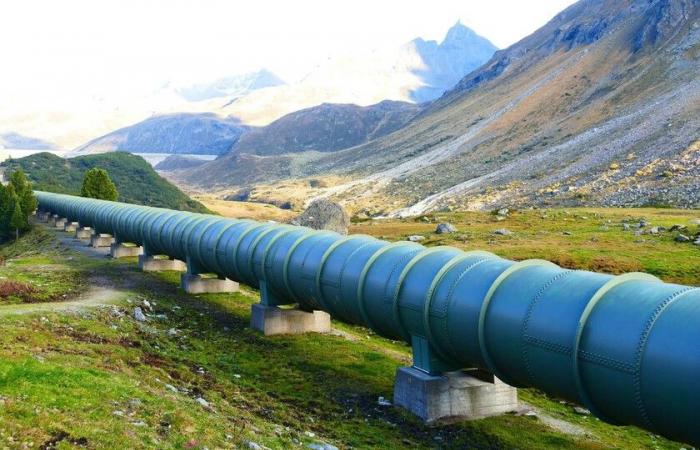
-
The electrical grid barely stores energy, and therefore does not take advantage of the surplus produced by wind and solar energy.
-
The ideal vector to store renewable energy is hydrogen, and Spain is positioned to lead the change
Europe needs better infrastructure to manage its current overproduction of renewable energy, and Spain has the key to solve it: green hydrogen.
A flexibility problem. The rapid expansion of wind and solar projects has created an imbalance between electricity supply and demand in Europe. The price of electricity has plummeted because there is a lot of renewable energy during certain periods, but gas plants have to continue operating to compensate for the times when they are not.
The European electricity grid has a flexibility problem: it barely stores energy, and therefore does not take advantage of the surplus produced by wind and solar energy when the wind blows a lot or the sun shines a lot.
The role of green hydrogen. There are other options, such as pumped hydroelectric plants, which large electricity companies are betting on, but the ideal vector to store surplus energy is hydrogen. Especially green hydrogen, which is produced through water electrolysis from renewable energy.
Production can be done during times of low energy demand with seawater, adding a desalination plant to the process. The gas “stores” this renewable energy and can then be burned to stabilise the grid when the opposite situation occurs: high energy demand and low production of green hydrogen.
The great European bet. Green hydrogen has become a key piece in the European Union’s plans for the energy transition and the commitment to neutralize CO2 emissions, especially in sectors that are difficult to decarbonize, such as heavy industry and maritime and air transport.
It is not an easy path. Today, less than 0.1% of global hydrogen is produced by electrolysis due to its high costs. But there are laboratories around the world improving electrolyser technology to meet this challenge, and Europe is sticking to its guns.
Spain leads the change. Taking advantage of European investments, Spain has strengthened its position in the green hydrogen market with multiple agreements and projects that put it at the forefront of change.
In Andalusia, there is the Andalusian Green Hydrogen Valley project, with an investment of 5 billion euros to build a technological hub capable of producing up to 300,000 tons of green hydrogen. There is a similar project in Asturias called HyDeal Spain, which hopes to start with 200,000 tons of hydrogen per year by 2026 and 330,000 tons per year by 2030.
Transform your home with the energy of the sun. At Comunidad Solar, we install high-efficiency photovoltaic panels so you can enjoy clean electricity and savings on your bill. With the best technology on the market and unparalleled service, we ensure your total satisfaction.
Advice offered by the brand
The H2Med corridor. But the real ace up Spain’s sleeve is the European H2Med corridor, a green hydrogen gas pipeline that will connect the Iberian Peninsula with the rest of Europe in 2030.
The pipeline will have a 455-kilometre underwater section between Barcelona and Marseille and a 248-kilometre terrestrial section between Celorico da Beira and Zamora. A section along the Cantabrian Coast, the Ebro Valley and the Levante, of around 1,500 kilometres. And another section along the Vía de la Plata between Gijón and Huelva, with a small detour to connect with the Puertollano Hydrogen Valley, of 1,250 kilometres.
And several reservations. As part of the H2Med project, Barcelona will have a 140 MW compression station, and another 24.6 MW station in Zamora. Two underground hydrogen reserves are also planned, located in the Cantabrian Coast, with capacities of 335 and 240 GWh.
With the planned production, 10% of the renewable hydrogen objective of the RePower EU plan would be reached, which seeks to reach 20 million tons by 2030.
The first hydroduct. The first pipeline through which green hydrogen will circulate in Spain is in Mallorca and has just entered the final phase of its construction.
It will transport 300 tonnes of green hydrogen produced by electrolysis, which, upon reaching the plant, will be injected into the 1,200 km natural gas network already built in Mallorca. The project promises to save 20,700 tonnes of CO2 annually on the island.
Many challenges to solve. Transportation is just one of the great challenges of green hydrogen. Spain aspires to lead hydrogen thanks to its hydroducts, but other countries like Australia, too far away to make pipelines, are working to facilitate its transportation by ships.
The most limiting challenge is that, today, green hydrogen multiplies the price of natural gas by eight. More efficient turbines, electrolyzers and desalination plants are needed, as well as wind and solar plants that produce cheaper electricity. For now, the European Hydrogen Bank has laid the first stone: facilitating initial investments.
Image | Rawpixel (CC0 1.0)
In Xataka | Europe starts up the first hydrogen turbine capable of powering 500,000 homes. You need it to stop using natural gas.

